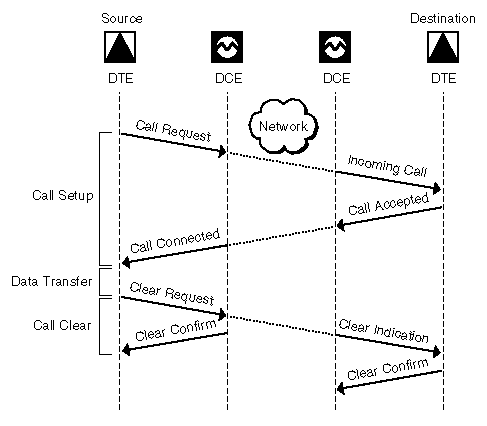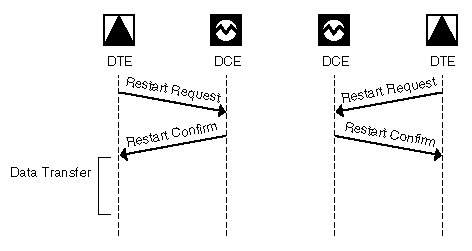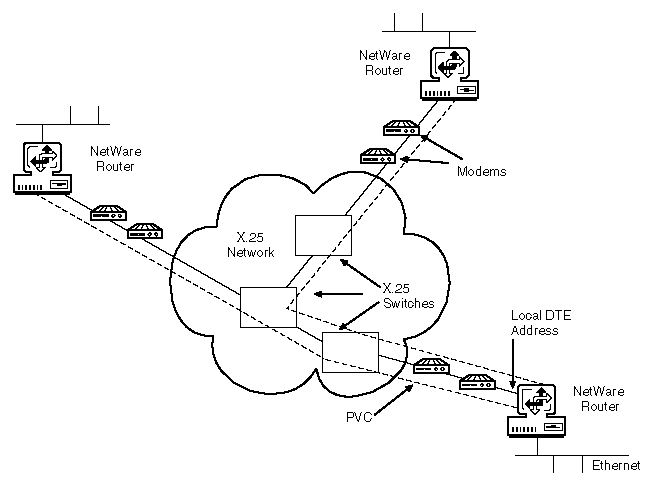

  |
The NetWare Link/X.25 Packet layer multiplexes a physical link onto multiple channels using a virtual circuit. A virtual circuit gives the DTE user the impression that the connection with another DTE is unique and not shared. In reality, the user is sharing communication links with other virtual circuits or connections.
X.25 provides for two types of virtual circuits: SVCs and PVCs. For more information about virtual circuits, refer to:
An SVC is a dynamically established on-demand virtual circuit that uses call setup and call-clearing procedures. A call is made between DTEs, a connection is established, data packets are sent, and the call is disconnected when the transmission is complete. This is similar to using an ordinary telephone, whereby the user dials any number. The connection lasts only for the duration of the call.
Three types of SVCs are available:
A PVC is a permanent, network-assigned virtual circuit that requires no call setup or clearing. PVCs are like leased lines, whereby two phones are permanently connected to each other. There is no overhead in call setup for PVCs because no call setup is required. They are expensive, however, because they are permanent connections.
Figure 4 and Figure 5 show examples of an SVC and a PVC, respectively.
In Figure 4, a virtual call is initiated with a Call Request packet sent by the local DTE. The network routes the request to the DCE to which the destination DTE is connected. The DCE selects a free logical channel and sends an incoming Call Request packet to the called DTE. If the called DTE accepts the call, it sends a Call Accepted packet through the same logical channel number (LCN) as the Call Request packet. The call is established and the data exchange takes place.
Figure 4
Switched Virtual Circuit
As shown in Figure 5, there is no need for a call setup procedure. After the restart procedure is complete, the DTEs can exchange data immediately.
Figure 5
Permanent Virtual Circuit
NetWare Link/X.25 can route IPX and SNA traffic over PVCs. You can set up SVCs that can be connected manually or automatically. The router can maintain IP, IPX, and AppleTalk connections manually by using SVCs between multiple sites. Links that are set up manually are easy to install and maintain because they use routing table updates to discover end-user stations and hosts for each X.25 destination automatically. The router can establish and disconnect IP connections automatically using SVCs. The types of connections supported by NetWare Link/X.25 are shown in Table 2.
Table 2. Connections Supported by NetWare Link/X.25
| Connection | PVC | Permanent SVC | On-Demand SVC |
|---|---|---|---|
IPX |
X |
X |
X |
IP |
X |
X |
X (RFC 1356) |
AT |
X |
X |
X |
SNA |
X |
X |
|
BRIDGE |
X |
X |
|
A permanent SVC is left in a connected state until the user or application brings it down.
An on-demand SVC is brought down when the idle timer has expired. The idle timer is user-configurable. The circuit remains down until more data is queued up to be sent, which is when the connection is reestablished.
Setting up a logical connection requires establishing a logical channel or path. Once the logical channel is established between two DTEs, the packets are transferred between connected ends as needed.
Each packet is associated with a logical channel, which is mapped to the appropriate destination of the virtual circuit. The virtual circuit is assigned a unique number between 1 and 4,095, called the logical channel number (LCN). This enables a more effective use of the access circuit for the available bandwidth and the traffic density for each logical channel. The logical channel is the mechanism that allows multiple simultaneous virtual circuits across a physical link.
A DTE can establish up to 4,095 simultaneous virtual circuits with other DTEs on a single physical DTE/DCE link. A packet associated with a virtual circuit can be sent in either direction on a circuit at any time. This is called full-duplex statistical multiplexing. The packets are statistically multiplexed with packets of other communicating users, thus optimizing the transmission media of the network.
The data packets are routed automatically to the appropriate destination, as shown in Figure 6.
Figure 6
Virtual Circuit Setup
Logical channels differentiate among the virtual circuits supported at the packet level. Multiple communications are provided simultaneously by multiplexing virtual circuits over the access line. One PVC or SVC is established at a time on each logical channel.
To determine which packet goes on which circuit, each packet flowing across the X.25 interface contains a 12-bit virtual circuit number. This number identifies a logical channel and is called the LCN. The 12-bit number is expressed as a 4-bit logical group number and an 8-bit LCN number.
Virtual circuit numbers are assigned according to a preset network arrangement, in which zero is reserved for restart and diagnostic packets for all circuits. Contiguous ranges of numbers are assigned for four categories of virtual circuits: PVCs, one-way incoming virtual circuits, one-way outgoing virtual circuits, and two-way virtual circuits.
For SVCs, the association between a logical channel identifier and a particular virtual circuit is accomplished at call setup time, when the identifier is chosen from a pool of unused identifiers. For PVCs, this association is by network subscription. At network subscription time, the user specifies the number of logical channels needed for both SVCs and PVCs (up to 255). The user also must specify the ranges for the incoming virtual circuit, the two-way virtual circuit, and the outgoing virtual circuit.
  |